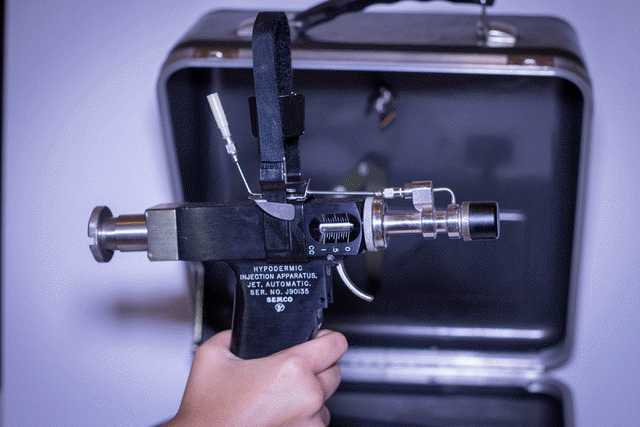|
|
|||||||||||||||||||||||||||||||||||||||||||||
|
|
|||||||||||||||||||||||||||||||||||||||||||||
|
Fatal
Bacterial
Infections
Associated
With
Platelet
Transfusions—United
States, 2004
JAMA. 2005;293:2586-2591. MMWR. 2005;54:168-170 Each year, approximately 9 million platelet-unit concentrates are transfused in the United States1; an estimated one in 1,000-3,000 platelet units are contaminated with bacteria, resulting in transfusion-associated sepsis in many recipients.2 To reduce this risk, AABB (formerly the American Association of Blood Banks) adopted a new standard on March 1, 2004, that requires member blood banks and transfusion services to implement measures to detect and limit bacterial contamination in all platelet components.3 This report summarizes two fatal cases of transfusion-associated sepsis in platelet recipients in 2004 and describes results of a 2004 survey of infectious-disease consultants regarding their knowledge of transfusion-associated bacterial infections and the new AABB standard. Health-care providers should be aware of the new standard and the need for bacterial testing of platelets to improve transfusion safety. However, health-care providers also should be able to diagnose transfusion-associated infections, because even when testing complies with the new standard, false negatives can occur and fatal bacterial sepsis can result. Case Reports
Patient A. In October 2004, a man aged 74 years in Ohio with leukemia received a transfusion consisting of a pool of five platelet unit concentrates. Before transfusion, the pooled platelet unit had been tested for bacterial contamination with a reagent strip test (Multistix®, Bayer Diagnostics, Tarrytown, New York) to determine the pH level, a means for detecting the presence of bacteria. Because the pH test result was within the accepted range for quality control (i.e., pH > 6.4) of the clinic’s blood bank, the pooled unit was approved for transfusion. After transfusion, the patient had hypotension the same day and was admitted to a local hospital. The patient’s blood cultures grew Staphylococcus aureus, and the patient died 21 days after hospital admission. S. aureus also was cultured from the leftover platelet unit bag; isolates from the patient’s blood and the platelet bag were indistinguishable by pulsed-field gel electrophoresis (PFGE). Patient B. In December 2004, a man aged 79 years in Utah received a transfusion of pheresis platelets for thromobocytopenia after coronary artery bypass surgery. Before transfusion, platelets from the unit bag were tested for bacterial contamination with liquid culture media (BacT/Alert®, BioMerieux Inc., Durham, North Carolina) by using 4 mL in a standard aerobic blood culture bottle and were found to be negative after 5 days’ incubation. Approximately 1 hour after transfusion, the patient had shortness of breath, chills, and a temperature of 102.9°F (39.4°C) and became hypotensive. Subsequently, the patient had multiple thrombotic events and died 27 hours later. S. lugdunensis was cultured from the patient’s blood and the leftover platelet bag; these isolates were indistinguishable by PFGE.
To assess clinician experience with transfusion-associated bacterial infections and knowledge of the new AABB standard, the Infectious Diseases Society of America (ISDA) conducted a survey of infectious-disease consultants in the United States. The survey was distributed via e-mail and fax during July 27–August 24, 2004, to all 870 infectious-disease consultant members of the Emerging Infections Network, a sentinel provider network of ISDA.4 Completed surveys were received from 399 (46%) of the 870 members. Forty-eight (12%) respondents recalled consulting on 85 reactions to blood transfusions (i.e., of all types) potentially caused by bacterial contamination; 10 reactions were fatal. In 26 (31%) cases, contamination was confirmed by positive cultures of the recipient’s blood and transfused unit. The most common pathogens recovered were Staphylococcus and Serratia spp. A total of 143 (36%) respondents reported they were aware that bacterial contamination of platelets is one of the most common infectious risks of transfusion therapy. Seventy-eight (20%) indicated they had been familiar with the new AABB standard for bacterial detection in platelets before the survey; 359 (90%) believed health-care providers need to be aware of the standard. Reported by: A Arendt, MPH, Cuyahoga County Board of Health; J Carmean, E Koch, MD, Ohio Dept of Health. R Rolfs, MD, S Mottice, PhD, Utah Dept of Health. Infectious Diseases Society of America Emerging Infections Network, Alexandria, Virginia. L Strausbaugh, MD, L Liedtke, MS, Veterans Affairs Medical Center and Oregon Health and Science Univ, Portland, Oregon. A Srinivasan, MD, J Hageman, MHS, D Jernigan, MD, Div of Healthcare Quality Promotion, M Kuehnert, MD, Div of Viral and Rickettsial Diseases, National Center for Infectious Diseases; P Rao, PhD, S Kazakova, MD, C Porucznik, PhD, EIS officers, CDC. CDC Editorial Note: Transfusion-associated bacterial sepsis is the second most frequently reported cause of transfusion-related fatalities in the United States, accounting for 46 (17%) of 277 reported transfusion deaths during 1990-1998.5 Contaminated platelets are estimated to cause life-threatening sepsis in one in 100,000 recipients and immediate fatal outcome in one in 500,000 recipients. These risks are greater than those estimated for transfusion-transmitted viral infections (e.g., hepatitis C virus [HCV] or human immunodeficiency virus [HIV]).6 In addition, because bacterial infections attributed to contaminated platelets are underreported, the actual risk to transfusion recipients is likely greater than present estimates.7 Health-care providers should be aware of bacterial contamination as a potential cause of transfusion reaction so they can diagnose illness, treat patients appropriately, and evaluate interventions that might prevent additional transmissions. Platelets are particularly vulnerable to bacterial growth because they are stored at room temperature for up to 5 days, whereas other blood components are refrigerated or frozen. Gram-positive bacteria (e.g., Staphylococcus spp.) found on skin are the most frequent contaminants of platelet units. Although less commonly recognized as contaminants, gram-negative bacteria (e.g., Serratia, Enterobacter, or Salmonella spp.) account for more severe and often fatal infections and are attributed to donor bacteremia or contamination during product processing.6 Bacterial contamination of the blood component often is not considered in the differential diagnosis at the time of transfusion reaction because signs and symptoms (e.g., fever, rigors, or change in blood pressure) are similar to those expected from sepsis from other causes.7 AABB has suggested several strategies to assist transfusion services and blood banks in reducing transfusion of bacterially contaminated platelet components and complying with the new standard, including testing for contamination and methods for improved skin disinfection. The College of American Pathologists has also added bacterial contamination testing to the transfusion medicine checklist of their Laboratory Accreditation Program.8 The Food and Drug Administration (FDA) has approved three bacterial culture systems for use in quality-control testing to monitor contamination of platelets (BacT/Alert®; Scansystem®, Hemosystem, S.A., Marseille, France; and Pall eBDS, Medsep Corporation, Covina, California). However, despite the new AABB standards, approaches to testing vary and do not always include culture-based methods. The use of pH tests such as the one used on the platelet unit for patient A are also an option under the AABB standard. Apheresis platelets are derived from single donors; whole-blood–derived platelets are pooled from multiple donors. Most blood-collection centers culture only apheresis platelets and release the unit after culture; most commonly, the unit is held for 12-48 hours of incubation before release. Hospital transfusion services are responsible for bacterial testing of whole-blood–derived platelets. Because pooling is performed immediately before transfusion, culture-based tests are logistically difficult and costly to implement for whole-blood–derived platelets. Some hospitals have implemented non–culture-based methods (e.g., glucose or pH indicators) to test whole-blood–derived platelets, although the sensitivity of these methods generally is less than culture-based methods and can result in frequent false-negative results.9 However, as the cases described in this report illustrate, false-negative results can result from both culture and nonculture testing methods. In addition, deviation from culture methods that meet manufacturer’s recommendations (e.g., decreased blood volume) can result in reduced sensitivity and produce false negatives. For patient B, the volume of the platelet sample was less than the manufacturer’s recommended volume for platelet screening. The survey of infectious-disease consultants provides an indication of the gap in clinician knowledge of transfusion-associated bacterial infections. Only 36% of respondents were aware that bacterial contamination of platelet transfusion is one of the most common infectious risks from transfusion, and only 20% were familiar with the new AABB standard for bacterial testing of platelets. AABB and other accrediting organizations recommend that health-care facilities implement protocols to help clinicians recognize and manage transfusion reactions, including those potentially caused by bacterial contamination. Post-transfusion notification of appropriate persons (e.g., clinicians caring for the patient) is recommended if cultures identify slow-growing bacteria after product release or transfusion. If bacterial contamination of a component is suspected, the transfusion should be stopped immediately, the unit should be saved for further testing, and blood cultures should be obtained from the recipient. Bacterial isolates from cultures of the recipient and unit should be saved for further investigation. To improve bacterial testing and reporting, AABB provided additional guidance10 on standardized definitions for test results, investigation and management of implicated units and associated co-components, and laboratory testing of detected organisms. Guidance relevant for clinicians includes (1) situations in which a positive test result is encountered after transfusion of the unit or a recipient has post-transfusion bacteremia after receiving platelets that tested negative, (2) management of potentially infected donors, and (3) algorithms to be followed when organisms detected in donor testing are of clinical concern or public health importance (e.g., nationally notifiable to state and local health departments). Despite challenges in implementation since the AABB standard was introduced in 2004, bacterial testing of platelets is important to improving transfusion safety. Detection of contaminated units can protect not only the potential recipient of the platelet unit, but potential recipients of other blood units, by identification and recall of co-components that also might be contaminated. However, regardless of method, bacterial screening is unlikely to detect all pathogens. Health-care providers should be aware of the risk for bacterial contamination of blood products, particularly platelets, and consider the possibility of bacterial contamination when investigating febrile transfusion reactions. Clinicians should collaborate with hospital transfusion services, blood-collection centers, and public health agencies to manage suspected infections in blood donors and recipients. Transfusion-related fatalities should be reported to FDA, Center for Biologic and Evaluation Research (telephone, 301-827-6220; e-mail, fatalities2@cber.fda.gov ).
1. Sullivan MT, Wallace EL. Blood collection and transfusion in the United States in 1999. Transfusion. 2005;45:141-148. CrossRef | ISI | MEDLINE
|
|
|
|





